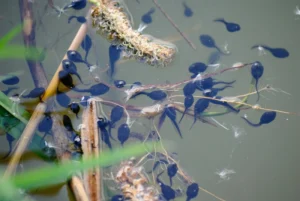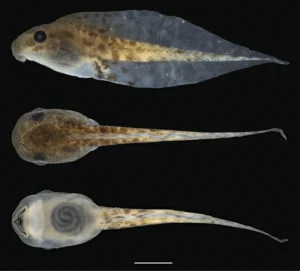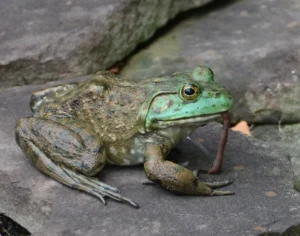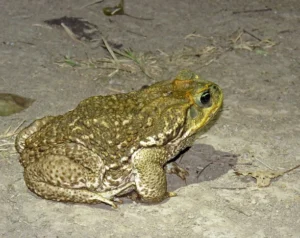Frogs are amphibians, which means they live part of their lives in the water and part on land. They typically start their lives as fully aquatic tadpoles, which metamorph into mature frogs over time. In each of these life stages, they will have different diets.
Frog tadpoles are mostly herbivorous and eat algae and aquatic plants. As they grow, the tadpoles become omnivores and will eat tiny insects and other animal protein, in addition to plants. Once the tadpoles go through the process of metamorphosis and transform into frogs – they become obligate carnivores.
In each of their life stages, frogs have different digestive systems, suited for their different diets. Tadpoles have long, tightly coiled intestines, suited for digesting plant matter, while adult frogs have short digestive tracts, suited for their strictly carnivorous diets.
How a few frog/toad species, are known to eat plant-based food in addition to prey even as adults, which means they are omnivores, rather than obligate carnivores (more information on that is below).
Frog Tadpoles Are Mostly Herbivorous
Frogs start their lives as tiny embryos inside egg sacs. Their first food source for the developing embryos is the yolk of their eggs.
The yolk provides enough nutrition to sustain the developing tadpoles until they are ready to hatch into the water. This can take anywhere from a few days to as long as 6 weeks, depending on the species.
After hatching, the tadpoles will have poorly developed gills, mouths, and tails – so they can not properly swim or eat yet.
For this reason, they will spend the first few days feeding on the remaining yolk of the eggs. This will provide them with enough energy to grow and develop further.
After about a few days, the tadpoles would have developed enough to start free swimming and feeding on food sources available in the water.

At this early stage, tadpoles are almost completely herbivorous, and will eat:
- Algae
- Soft roots and leaves of aquatic plants (eg. duckweed mosses)
- Phytoplankton
- Detritus (mostly composed of degraded plant materials)
Tadpoles have little or no tongue-like tissue and will eat by sucking the food into their throat and the food enters the long intestine where it is digested.
Due to a mostly herbivorous diet, tadpoles have very long tightly coiled intestines, that make up more than half of their body mass.
Plants contain cellulose, a compound that is very hard to digest. Because of this, plant matter needs to spend more time in the digestive system. This long intestinal tract gives tadpoles more time to break down the plant matter and absorb as many nutrients as possible.
The intestine takes up about half the space within the tadpole’s body and can be more than ten times longer than the tadpole itself.
It is also its largest organ and is visible through the translucent belly skin.

Tadpoles Become Omnivores
A few weeks into their development (can vary depending on the species), the tadpoles start to grow legs, starting with the back legs. Their digestive tract will also gradually shorten.
Tadpoles at this stage become omnivores and will eat animal matter in addition to plants.
They will also eat:
- Aquatic insect larvae (glass worms, mosquito larvae, etc)
- Water striders
- Zooplankton
- Small insects that fall into the water
- Worms
- Carcasses in the water
Large tadpoles may also eat small and immature fish, small snails, slugs, fairy shrimp, and other small aquatic invertebrates.
Food Item |
Early Tadpole |
Late Tadpole |
| Algae | Yes | Yes |
| Plankton | Yes | Yes |
| Aquatic plants | Yes | Yes |
| Detritus | Yes | Yes |
| Ants | No | Yes |
| Small insects | No | Yes |
| Worms | No | Yes |
| Carcasses | No | Yes |
| Fish eggs | No | Yes |
| Fairy shrimp | No | Yes |
Tadpoles Turn Into Froglets
After a few months, to a few years (depending on the species) the tadpoles will go through a process known as metamorphosis, in which they will transform into juvenile frogs.
During this process, the tadpoles:

- Lose their gills and get well-developed lungs for breathing air
- Absorb the tail into the body
- Develop strong legs for moving on land
- Remodel other organs to form an adult frog
The head structure also begins to change, leading to the development of a more defined jaw and the formation of a tongue.
In addition, the digestive tract shortens dramatically, and the inner lining of the remaining intestine thickens, creating many folds in the process. These folds create a very large surface for the absorption of nutrients during digestion.
Once metamorphosis fully is complete, the tadpoles are now young frogs and will leave the water for a mostly terrestrial, or semi-aquatic life (depending on the species).
These juvenile frogs will grow into adult frogs, and once they reach sexual maturity, they will typically go back to the water to mate and lay their eggs.
Froglets and Adult Frogs Are Generally Obligate Carnivores
Once the metamorphosis from tadpole to frog is complete – frogs become obligate carnivores, meaning they only eat animal matter and will not eat any plants.
They will eat :
- Snails, slugs
- Worms
- Milidpes, centipedes
- Beetles, flies, and a wide variety of other insects
Larger frog species also eat small fish, small birds, bats mice, small snakes, small lizards, and even smaller frogs, sometimes of their own species (yes, they can be cannibals).

They are opportunistic carnivores that will eat almost any prey they can catch, overpower, and fit into their mouths.
Most frogs are instinctively attracted to movement while hunting for food, and will not eat dead bugs or any other dead prey items.
Food Item |
Small Frogs |
Large Frogs |
| Ants | Yes | Yes |
| Insects | Yes | Yes |
| Worms | Yes | Yes |
| Snakes | No | Yes |
| Snails & Slugs | Yes | Yes |
| Spiders | Yes | Yes |
| Centipedes & Millipedes | Yes | Yes |
| Lizards | No | Yes |
| Mice | No | Yes |
| Birds | No | Yes |
| Bats | No | Yes |
| Vegetables | No | No |
| Fruits | No | No |
| Flowers | No | No |
| Leaves | No | No |
| Grass | No | No |
| Algae | No | No |
Froglets and Adult Frogs Have a Digestive System Suited for a Carnivorous Diet
Adult frogs have short alimentary canals, suited for their strictly carnivorous diets.
Carnivorous animals like frogs generally have shorter digestive tracts than herbivores – because meat is dense in nutrients and they can extract these nutrients easier.
Their stomachs also make up a larger part of their digestive system than herbivores.
In addition, frogs have very powerful digestive enzymes, that help them to easily digest animal protein.
However, adult frogs may occasionally ingest plant matter when they eat hunt and eat prey.
A study at Arkansas State University analyzed the stomach contents of 120 green tree frogs (Hyla cinerea), collected between May 1956 and October 2014 in Arkansas.
Plant matter was found in the stomachs of several frogs, suggesting that green tree frogs occasionally ingest plant matter when actively foraging.
However, this ingestion is purely accidental, as these frogs are obligate carnivores as adults – and do not eat plants.
Here is a table that summarizes everything easier:
Life Stage |
Diet |
| Early Tadpole | Herbivore |
| Late Tadpole | Omnivore |
| Froglet | Obligate Carnivore |
| Adult frog | Obligate Carnivore |
Some Adult Frog/Toad Species Are Omnivores
Cane toads (Rhinella marina) mostly eat insects, worms, snails, smaller frogs, small mammals, and other prey items.
However, they have also been observed eating carrion, processed cat and dog food, household garbage scraps, and even animal excreta.
This means they are omnivores, rather than obligate carnivores, like most frogs are in the adult life stage.

Unlike most frogs that find their prey by movement, cane toads primarily use vision to find prey, and can also use their sense of smell to find food, such as dog food left outdoors.
Izecksohn’s Brazilian Tree Frogs Are Unique
There is one frog that is known to eat plants as part of its regular diet: the Izecksohn’s Brazilian tree frog (Xenohyla truncata).
These frogs unique in that they are the only known frugivorous frog, out of more than 7,000 frog species in the world. They intentionally and often eats fruits, leaves, and flowers.
The amount of plant matter eaten by Izecksohn’s Brazilian tree frogs will depend on the blooming and fruiting seasons of the plants. When plants are unavailable, these frogs will eat various arthropods instead.
Since these frogs eat plants, in addition to animal matter, they are omnivores – rather than obligate carnivores.
Sources:
Thigpen, C. S.; Dodson, H.; and Trauth, S. E. (2016) “Food Habits of Green Tree Frogs (Hyla cinerea) from Arkansas,” Journal of the Arkansas Academy of Science:Vol. 70, Article 38. DOI: https://doi.org/10.54119/jaas.2016.7030 Available at: https://scholarworks.uark.edu/jaas/vol70/iss1/38
Altig, Ronald & Whiles, Matt & TAYLOR, CINDY. (2007). Whattadpoles really eat? Assessing the trophic status of an understudied and imperilled group of consumers in freshwater habitats. Freshwater Biology. 52. 386 – 395. 10.1111/j.1365-2427.2006.01694.x.
Schreiber, Alexander & Cai, Liquan & Brown, Donald. (2005). Remodeling of the intestine during metamorphosis of Xenopus laevis. Proceedings of the National Academy of Sciences of the United States of America. 102. 3720-5. 10.1073/pnas.0409868102.
Da Silva, Helio & Britto-Pereira, Monica & Caramaschi, Ulisses. (1989). Frugivory and Seed Dispersal by Hyla truncata, a Neotropical Treefrog. Copeia. 1989. 781–783. 10.2307/1445517.


